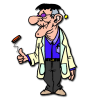Yes
How to Access the Disk Management UtilityTo access the
Disk Management utility in Windows 7, go to the
Start Menu, right-click on
Computer, and select
Manage. This will bring up your
Computer Management window.
On the left-hand side, select
Disk Management from the
Storage section.
In the
Disk Management section, you'll see the right-hand side of the window populate with your disk information, showing you the name, size, and type of each partition for the disks on your system.
Please keep in mind that the
Disk Management utility can only manage file systems compatible with Windows operating systems, such as FAT16/FAT32 and NTFS. While it can see other types of partitions, such as ones created and formatted by Linux or other operating systems, it can only delete them. For more information on partition types, please see: Wikipedia's page on
File Systems.
Deleting a Disk PartitionIn some cases you'll want to remove a partition from your hard drive, either to make space to extend an existing partition, or redo the partition as a different size of File System. To remove a partition, right-click on the partition you're trying to remove and select
'Delete Volume'.
You'll be prompted to confirm your choice, to make you aware that if you remove the partition all data on it will be erased. Therefore, please make sure you've backed up any critical data on that partition prior to clicking
Yes.
You'll now see the deleted partition showing as
'Free space' in the
Disk Management utility.
Creating a Disk PartitionIf you have "free" space on your hard drives, you can create partitions using the
Disk Management utility. The actual logic behind using Primary, Extended, and Logical partitions is outside the scope of this tutorial. However, we recommend this very informative article, called
What is a Partition.
You'll see unpartitioned space highlighted and labeled as
'Free space'.
To create a partition here, right-click the free space and select
'New Simple Volume' to bring up the
'New Simple Volume Wizard.'. Click
Next.
The wizard will ask you for the size of the partition, which you can specify as you wish, using all or part of the total partition size.
Click
Next where the Wizard will ask you to assign a drive letter to the partition or choose a different letter than the default one and, when done click
Next.
You'll be asked for information on how the partition should be formatted. Keep in mind that if you wish to use this partition, it needs to be formatted. In most cases, you'll want to use NTFS. NTFS is the default and preferred file system since Windows NT, and provides increased performance, security, and fault tolerance compared to FAT16/FAT32.
SO the short answer is delete one and extend one of the other two into the unallocated space. -therefore ending with the two you wish and as recommended by my colleagues
NOTE the unallocated space must be to the right of the one you extend, when using disc management
If you use Easeus partition manager which is free, you can extend either way, either to the left right, but it is in your case easier to stay with disk management and simply start again as you wish.
You may of course ignore the references to Operating systems as you are of course using this HDD only for data storage



















 Sign In
Sign In Create Account
Create Account

